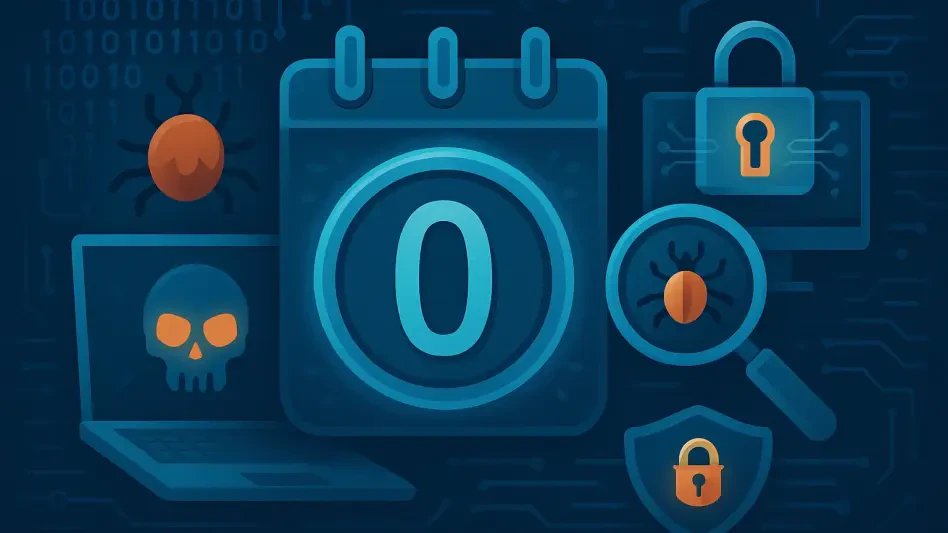In the ever-evolving realm of cybersecurity, the current year has emerged as a battleground marked by an unprecedented surge in zero-day vulnerabilities—those critical security flaws unknown to vendors or the public at the moment of exploitation, posing severe risks to systems worldwide. These threats carry a unique and sinister weight, as attacks frequently unfold before any patches or defensive measures can be rolled out, leaving systems and organizations dangerously exposed. From personal devices nestled in the hands of everyday users to the sprawling infrastructure that powers global enterprises, no corner of the digital landscape remains untouched by this rising tide of exploits. The sheer speed at which these vulnerabilities are weaponized is nothing short of alarming, often occurring within mere hours of their disclosure, compressing the window for response to a razor-thin margin. This article delves into the intricate and urgent challenges posed by these exploits, exploring the sophistication of the threat actors behind them, the diversity of targeted platforms, and the pressing need for a fundamental shift in defensive strategies. As the volume of vulnerabilities climbs—with over 23,600 published in just the first half of this year—the cybersecurity community faces a pivotal moment to adapt and counter an adversary that grows more cunning and relentless by the day.
Rapid Escalation of Exploit Speed and Volume
The defining characteristic of zero-day threats this year is the breathtaking speed at which vulnerabilities are turned into weapons. Attackers have honed their ability to exploit flaws almost instantaneously, often within 24 hours of a vulnerability’s disclosure to the public or vendors. This rapid weaponization is fueled by advanced automation tools and pre-developed exploit kits that allow malicious actors to strike before organizations can even begin to mount a defense. Nearly 30% of Known Exploited Vulnerabilities (KEVs) fall into this category of near-instant exploitation, creating a scenario where traditional response timelines are rendered obsolete. The shrinking window for action places immense pressure on cybersecurity teams, who must now contend with the reality that damage can spread across systems long before a patch is even on the horizon. This trend underscores a critical need for predictive analytics and preemptive measures that can identify potential weaknesses before they are exploited.
Complementing this speed is the staggering volume of vulnerabilities surfacing in the digital ecosystem. Data reveals a 16% increase in published vulnerabilities compared to the previous year, with over 23,600 recorded in the first six months alone. This surge indicates not only a growing number of flaws being uncovered but also a heightened interest from attackers in capitalizing on them. The sheer scale of the problem overwhelms even well-resourced organizations, as cybersecurity teams struggle to prioritize and address an ever-expanding list of threats. Beyond the numbers, this trend highlights a broader systemic challenge: the accelerating pace of software development and deployment often outstrips the capacity to secure it. As new technologies and updates roll out at breakneck speed, the potential for undiscovered flaws multiplies, creating fertile ground for zero-day exploits to thrive.
Sophistication and Strategy of Modern Threat Actors
Behind the curtain of these zero-day exploits lies a roster of highly sophisticated threat actors, ranging from nation-state groups to advanced persistent threat (APT) collectives and ransomware gangs such as Qilin and Storm-2460. These entities are not mere opportunists; they operate with meticulous planning and deep technical expertise, crafting complex attack chains that can evade even the most fortified defenses. A prime example is the exploitation of Microsoft SharePoint vulnerabilities like CVE-2025-53770 and CVE-2025-53771, where attackers chain multiple flaws to achieve remote code execution and infiltrate enterprise environments. This level of precision and coordination demonstrates a shift from random attacks to highly targeted campaigns designed to maximize impact. The ability to bypass authentication mechanisms or exploit obscure system components reveals a profound understanding of their targets, making these adversaries formidable foes in the cybersecurity arena.
The focus of these actors often centers on high-value targets, including government institutions, critical infrastructure sectors, and influential individuals whose compromise can yield significant strategic or financial rewards. Whether driven by motives of espionage, disruption, or monetary gain, their attacks are tailored to exploit the most sensitive and consequential systems. For instance, mobile spyware campaigns targeting Android and Apple devices aim at high-profile users, seeking to extract sensitive data or monitor activities covertly. This strategic approach transforms each zero-day exploit into a potential crisis, demanding that defenders not only react swiftly but also anticipate the next move of adversaries who operate with calculated intent. The stakes are elevated further by the involvement of nation-state actors, whose resources and persistence add a geopolitical dimension to the threat landscape.
Broad Spectrum of Targeted Platforms
The diversity of platforms under siege from zero-day exploits this year paints a sobering picture of a threat landscape with no safe havens. Web browsers, often the first point of contact for many users, face relentless attacks, with Google Chrome vulnerabilities such as CVE-2025-10585 exposing users to arbitrary code execution through malicious JavaScript or crafted web content. These flaws serve as gateways for attackers to compromise endpoints, leveraging the ubiquity of browsers to reach a vast pool of potential victims. The rapid patching efforts by vendors—sometimes within 24 hours—demonstrate responsiveness, yet the persistent targeting of such platforms, with multiple exploits recorded, signals their critical role in attack strategies. This widespread exposure necessitates robust endpoint protection and user awareness to mitigate risks at the initial point of interaction.
Mobile ecosystems are equally vulnerable, with platforms like Android and Apple iOS/macOS becoming focal points for targeted attacks, often linked to spyware operations against high-value individuals. Vulnerabilities such as CVE-2025-43300 in Apple’s ImageIO framework enable arbitrary code execution via malicious image files, showcasing how even ecosystems once deemed relatively secure are now under intense scrutiny from sophisticated adversaries. Android flaws, including CVE-2025-38352, facilitate local privilege escalation and sandbox escapes, amplifying the risk of deep system compromise. The shift in attacker focus toward mobile devices reflects their growing importance in both personal and professional spheres, as well as the wealth of sensitive data they hold. Protecting these platforms requires not only timely updates but also advanced behavioral detection to identify and block covert exploitation attempts.
Enterprise systems bear a significant share of the zero-day burden, with software like SAP NetWeaver facing catastrophic vulnerabilities such as CVE-2025-31324, which carries a rare maximum CVSS score of 10.0 for unauthenticated file uploads leading to full system takeover. Microsoft SharePoint and Windows also suffer from chained exploits that pave the way for ransomware deployment by groups like Storm-2460, impacting sectors from IT to finance. These incidents reveal the devastating potential of zero-days to disrupt business operations and compromise critical data, often through intricate attack sequences that exploit multiple flaws in tandem. The ripple effects of such breaches can cripple organizations, emphasizing the need for segmented architectures and continuous monitoring to limit the spread of an attack once a foothold is gained.
Network infrastructure, often the backbone of organizational connectivity, is another prime target, as evidenced by Citrix NetScaler’s CVE-2025-7775, a memory overflow flaw with a CVSS score of 9.2 that enables unauthenticated remote code execution. With over 28,200 exposed instances identified post-disclosure, this vulnerability offers attackers a direct path to infiltrate broader networks, often deploying web shells for persistent access. Such exploits highlight the critical role of network appliances as entry points that, if compromised, can jeopardize entire systems. Mitigating these risks demands immediate upgrades to patched versions alongside robust perimeter defenses to detect and block unauthorized access attempts before they escalate into larger breaches.
Rethinking Defense in the Face of Evolving Threats
Traditional cybersecurity approaches, heavily reliant on reactive patching, are proving woefully inadequate against the zero-day threats dominating this year’s landscape. Many exploits strike before patches are even developed, leaving systems defenseless in the critical early stages of an attack. Even when fixes are released, secondary waves of exploitation—often perpetrated by opportunistic actors using established web shells—continue to target unpatched or slowly updated environments. This persistent threat reveals a harsh truth: relying solely on after-the-fact solutions is a losing battle against adversaries who operate with speed and stealth. The inadequacy of this model is evident in cases like SAP NetWeaver, where post-disclosure attacks by ransomware groups complicate remediation efforts, underscoring the limitations of a patch-centric strategy in a zero-day era.
A fundamental shift toward proactive, defense-in-depth strategies is imperative to counter these evolving dangers. This approach assumes that compromise is not just possible but likely, focusing on resilience through layered security controls that can detect, contain, and respond to threats at multiple stages. Advanced threat detection tools, endpoint protection mechanisms, and network segmentation play crucial roles in disrupting multi-stage attack chains before they achieve their ultimate objectives. Continuous monitoring ensures that even subtle signs of exploitation are caught early, while rapid response capabilities minimize damage once a breach occurs. Collaboration within the cybersecurity community, through shared threat intelligence and joint disruption efforts, further strengthens defenses by providing insights into emerging tactics and vulnerabilities.
Looking back, the wave of zero-day exploits encountered this year served as a stark reminder of the relentless innovation of cyber adversaries. The lessons drawn from these incidents pointed to a clear path forward: organizations needed to build architectures designed to withstand unknown threats rather than merely react to known ones. By integrating predictive tools to anticipate vulnerabilities, fostering industry-wide partnerships to share critical intelligence, and investing in resilient systems that prioritized containment over cure, the groundwork was laid for a more robust defense. These steps, taken in response to the challenges faced, offered a blueprint for navigating the unpredictable terrain of cybersecurity, ensuring that future threats could be met with agility and strength.








